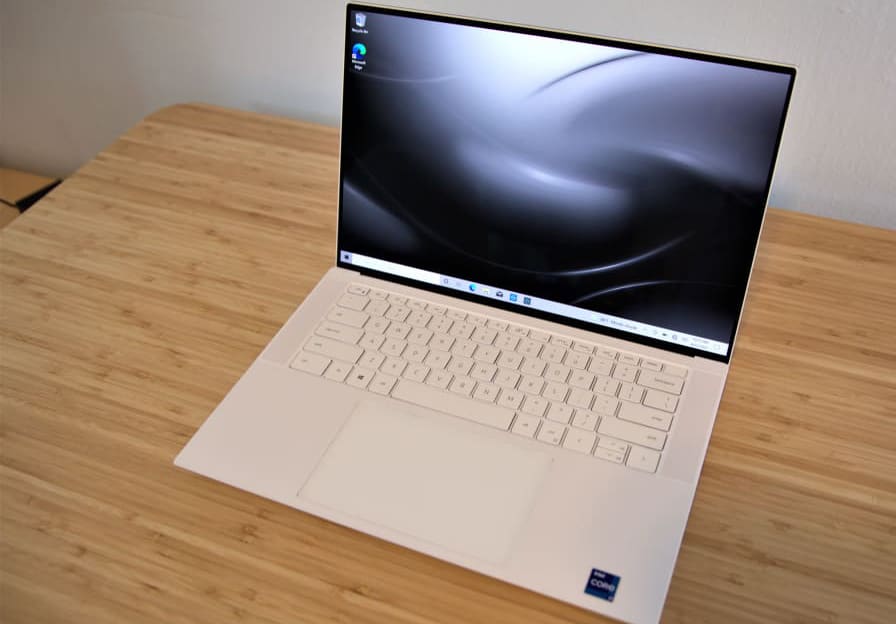Pros
-
Luxurious design
-
Excellent OLED display
-
Great battery life
Cons
-
Performance is just okay
-
Runs hot
About the Dell XPS 15 9510
Here are the specs of the unit we tested:
- Processor: Intel Core i7-11800H
- Graphics: Nvidia GeForce RTX 3050 Ti (45 watts)
- RAM: 16GB
- Storage: 512GB SSD
- Display: 3456 x 2160 60Hz 400-nit OLED
- Wireless connectivity: Wi-Fi 6, Bluetooth 5
- Wired connectivity: 2x Thunderbolt 4 / USB-C, 1x USB 3.2, 3.5mm audio jack
- Webcam: 720p
- Battery: 86 watt-hour battery (56 watt-hour on base model)
- Weight: 4.31 pounds
- Size: 13.57 x 9.06 x 0.71 inches
The Dell XPS 15 we received had several upgrades over the base model, which retails for $1,069.99. It had an Intel Core i7 processor, up from the base model’s Core i3, and Nvidia RTX 3050 Ti graphics, up from Intel’s UHD graphics. The RAM, storage, and display all received upgrades, too.
Our review unit rings up at a retail price of $2,449.99, and you can spend a lot more. The XPS 15 is available with an Intel Core i9 processor, up to 64GB of RAM, and up to four terabytes of solid state storage. That will cost you $3,849.99.
What we like
It looks stunning
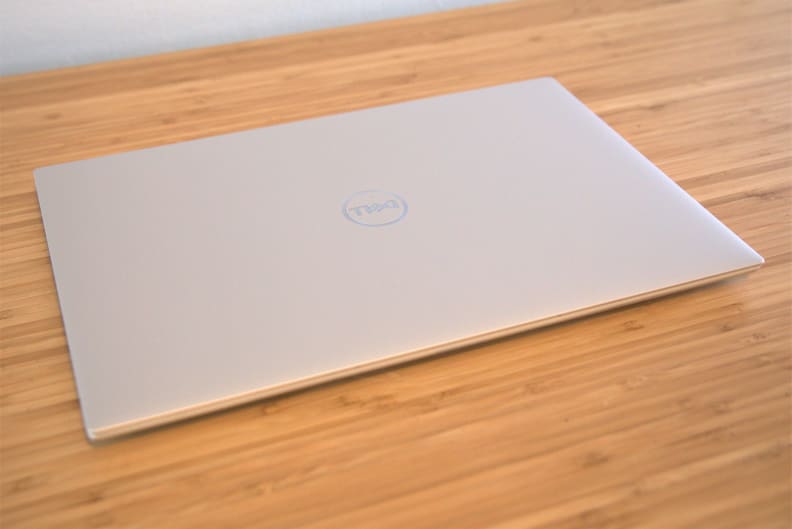
Dell's XPS laptops are the best-looking, thin and light laptops you can buy currently.
The XPS 15 melds form with function. Its design hasn’t changed much since 2015, but it still looks fresh and unique today. The spacious keyboard, bound on both sides by loud forward-facing speakers, looks great and is enjoyable to use. It’s paired with a massive, responsive touchpad measuring six inches wide and three and a half inches deep. This is the best Windows touchpad I’ve used this year. It doesn’t beat the vast expanse of touchpad found on the MacBook Pro 16, but it’s close.
Dell earns high marks for build quality and rigidity. The laptop’s chassis and display lid refuse to flex or bend when handled roughly. Picking the laptop up from a single corner doesn’t result in groans or creaks, as is true of many competitors.
On balance, the Dell XPS 15’s design is the best of any laptop sold today, including Apple’s MacBook line. It looks unique, feels luxurious, will fit in most laptop bags, and makes few compromises in the pursuit of style.
The OLED touchscreen is perfect for movies and games
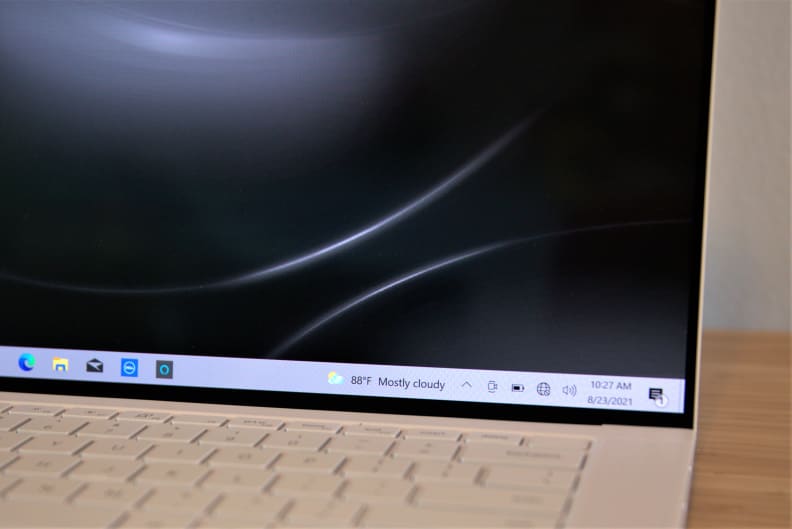
Dell continues to wow with its OLED displays in its XPS models.
Our Dell XPS 15 was configured with the OLED touchscreen, a $400 upgrade over the base 1080p LED. It’s pricey but worthwhile if you plan to watch movies, view high-resolution photos, or play games.
We measured a maximum contrast ratio of over 13,000:1. A conventional LED backlight laptop display will offer a ratio between 1000:1 and 1500:1. Improving contrast leads to a more realistic depiction of depth and dimensionality that helps draw you in. It also delivers better dark scene performance. A dark alleyway will look foreboding and a midnight sky will show well-defined, brilliant stars on a pitch-black background.
The XPS 15’s OLED has class-leading color performance. It provides full coverage of the wide DCI-P3 color gamut that is used for professional film and video production. It also has superb color accuracy that ensures the content you view looks as its creator intended. It’s ideal for digital artists in any field.
Dell calls the OLED a 3.5K display because it has a native resolution of 3456 x 2160. The odd pixel count is due to the display’s 16:10 aspect ratio, which is taller than the more common 16:9 aspect ratio. Choosing a 16:10 display helps Dell pack more vertical display space.
Don’t get hung up on the lack of full 4K resolution. The XPS 15 OLED’s pixel density is 261 pixels per inch, while 4K packs 283 pixels per inch at the same display size. This difference would be hard to notice with your nose touching the screen and becomes indistinguishable when a display is two or three feet away.
The battery holds up
Our Dell XPS 15 review unit had a large 86 watt-hour battery that powered the laptop for nine hours and seven minutes in our web browsing benchmark. This exceeds other premium 14-inch and 15-inch laptops we’ve recently tested. The HP Envy x360 15-inch lasted eight hours and 57 minutes, while the Lenovo Yoga 9i endured seven hours and 24 minutes.
The XPS 15’s battery life looks even better when you remember its performance. High-performance laptops, including gaming laptops, frequently end up at the bottom of battery rankings. Dell has dodged this issue.
Our battery benchmark is a light load focused on web browsing; we run a script in Chrome that automatically rotates between numerous websites until the battery dies. Using the laptop for photo editing consumed a charge more quickly, eating about 25% in an hour. The display can also reach a high level of brightness that will further shorten battery life. Your real-world results will vary based on how the laptop is used.
Buyers should know the base model has a smaller 56 watt-hour battery. This model has a 1080p display and less power-hungry hardware, though, so we suspect battery life is only slightly behind its big brother.
The connectivity is future-proof
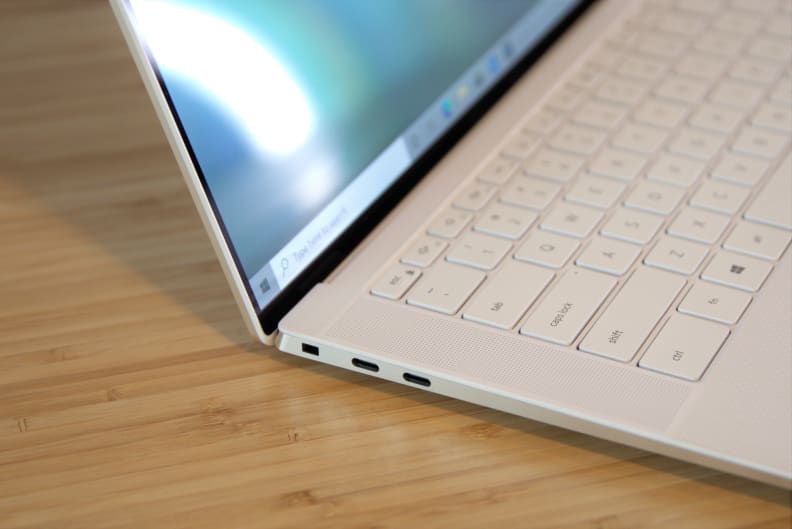
Dell's XPS 15 has USB-C and Thunderbolt 4 ports, which future-proof it for years to come.
The Dell XPS 15 commits to future-proof, versatile ports. It has two Thunderbolt 4 ports, which can also be used for USB-C devices, and a single USB-C port. There’s also a 3.5mm combo audio jack for headphones or microphones.
All three of the physical Thunderbolt and USB-C ports support power delivery and DisplayPort, which means they can be used to charge the laptop or connect an external display. Dell also throws in an SDcard reader, which should appeal to photographers, videographers, and some developers.
I suspect the laptop’s ports will feel just right in three to five years as progress slowly pushes USB-A out of our lives. However, most people still need to connect USB-A devices, an HDMI monitor, and Ethernet. You’ll need to buy a USB hub to use the XPS 15 with older peripherals.
Every XPS 15 has Intel’s Killer Wi-Fi 6 AX1650 wireless network adapter. It performed well, hitting Wi-Fi speeds of up to 635 megabits per second when in the same room as a TP-Link AX50 wireless router. It also hit 102Mbps from several rooms away. The laptop’s speedy Wi-Fi will help you forgive the missing Ethernet port. Bluetooth 5.1 is supported, as well.
What we don’t like
Performance is limited for the price
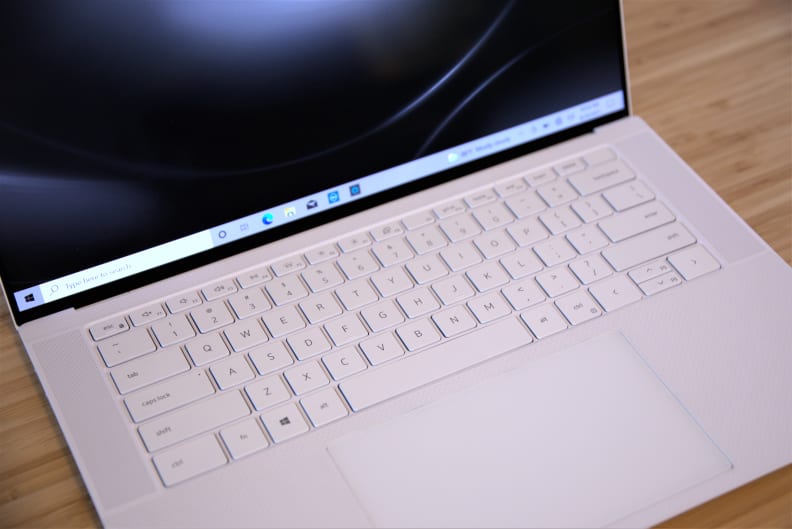
Dell has kept the same, simple chassis and keyboard design on its XPS laptops for several years, but it clearly works.
Dell sent us a powerful XPS 15 packing an Intel Core i7-11800H processor and Nvidia RTX 3050 Ti graphics solution. This combination delivered decent results but clearly had limitations.
GeekBench 5, a benchmarking application we use to measure CPU performance, hit a single-core score of 1526 and a multi-core score of 7914. That’s on par with other high-end laptops we’ve tested recently. The Acer Predator Helios 300, also powered by Intel’s Core i7-11800H, hit a single-core score of 1513 and a multi-core score of 7971. A Razer Blade 14 with AMD’s Ryzen 9 5900HX processor came behind the XPS 15 with a single-core score of 1217 and a multi-core score of 7481.
The XPS 15 was less impressive in real-world, application benchmarks. Rendering a 3D image of a car in Blender needed four minutes and one second to render on the Core i7 processor. The Acer Predator Helios 300 handled it in three minutes and 19 seconds. Dell’s laptop also trailed the other in our Handbrake transcoding test, converting a 4K video to 1080p. This suggests the XPS 15’s portable design forces the processor to throttle performance relative to thicker laptops that have more space for cooling the hardware.
Game performance is not impressive
While the base XPS 15 makes do with Intel’s barebones UHD integrated graphics, buyers can upgrade to Nvidia’s GeForce RTX 3050 or 3050 Ti (we tested the latter). Both are configured with a maximum power consumption of 45 watts. The RTX 3050 and 3050 Ti can be configured to use up to 80 watts of power, so the incarnation found in the Dell XPS 15 is a bit weak.
Far Cry 5 was the only game in our test suite that exceeded 60 frames per second at 1080p resolution with Ultra detail settings. Shadow of the Tomb Raider averaged 50 fps at 1080p with the graphics preset set to Highest. Total War: Warhammer II averaged 58 fps at 1080p and the Ultra preset.
We fired up Contro_l to put the Dell XPS 15’s ray tracing performance to the test—and it failed. The game scored an average of 18 fps at 1080p resolution with detail and ray tracing at High. _Control is playable on the XPS 15 but only exceeds 60 frames per second with Low detail and ray tracing turned off.
The Dell XPS 15’s game performance is just a hair better than last year’s typical budget gaming laptop with Nvidia GTX 1650 graphics. The HP Pavilion Gaming 15z, Acer Nitro 5, and Asus ROG Strix G512LI nip at the heels of the new XPS 15. In fact, the new Dell XPS 15 9510 model just slightly outperforms the old XPS 15 7590 with Nvidia GTX 1650 graphics.
It gets hot
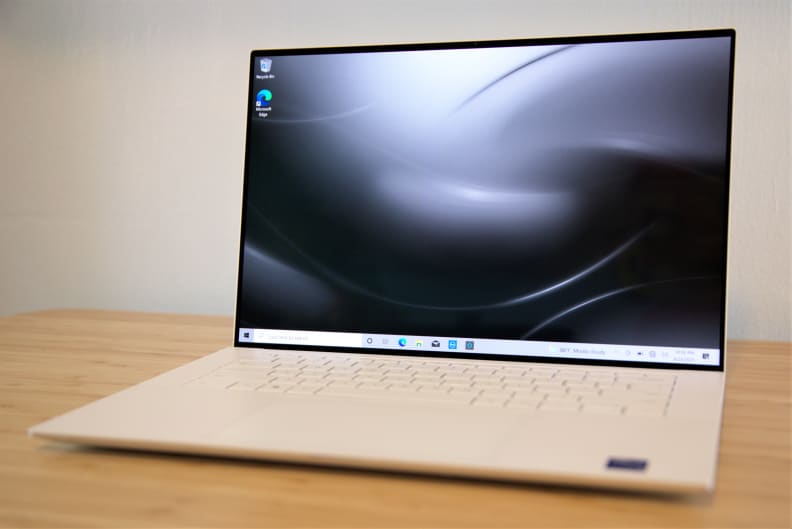
The Dell XPS 15 with an OLED might break your wallet, but all those extra features make it feel like a luxury.
Cramming powerful hardware in a thin chassis always leads to serious heat, and the Dell XPS 15 struggles with this issue. We recorded a maximum internal temperature of 100 degrees Celsius from the CPU. This is not an unusually high result for a modern laptop, but still...that’s the boiling point of water.
This heat makes its way through the chassis. The XPS 15 is comfortable to use when browsing the web or editing documents but demanding productivity apps and games make the laptop uncomfortable to use on, well, your lap. Placing the laptop on a desk will save your thighs but won’t relieve your sweaty palms.
Your ears will thank your palms for enduring the heat, at least. The laptop’s fans are noticeable at full load but tame compared to other laptops we’ve tested recently. The laptop’s cooling fans operate with a tame and consistent “whoosh” and lack a high-pitched whirr or rattle.
Should you buy it?
Yes, if you like luxurious laptops
The Dell XPS 15 nails the fundamentals of any great laptop. It’s attractive, enjoyable to use, and has a stunning OLED display (in the configuration we tested). These traits make it a superb laptop to use day-to-day for anything from web browsing to photo editing, programming, and 3D rendering.
It’s portable, too. The XPS 15 weighs a hair more than four pounds, is just seven-tenths of an inch thick, and is narrow enough to fit in most backpacks and messenger bags with a laptop compartment. The battery can last a full workday if you avoid demanding applications.
Performance is where shoppers might pump the brakes. The XPS 15 is fast, but its portability and design compromise some of the performance. Mid-range gaming laptops like the Acer Predator Helios 300 and Lenovo Legion 5 Pro Gen 6 will beat the XPS 15 in both games and demanding productivity apps like Blender or Cinebench. Those who need great performance at a reasonable price should look elsewhere.
But if you crave a laptop that feels like a luxury, the XPS 15 might be for you.
Meet the tester
Matthew S. Smith is a veteran tech journalist and general-purpose PC hardware nerd. Formerly the Lead Editor of Reviews at Digital Trends, he has over a decade of experience covering PC hardware. Matt often flies the virtual skies in Microsoft Flight Simulator and is on a quest to grow the perfect heirloom tomato.
Checking our work.
Our team is here to help you buy the best stuff and love what you own. Our writers, editors, and experts obsess over the products we cover to make sure you're confident and satisfied. Have a different opinion about something we recommend? Email us and we'll compare notes.
Shoot us an email
